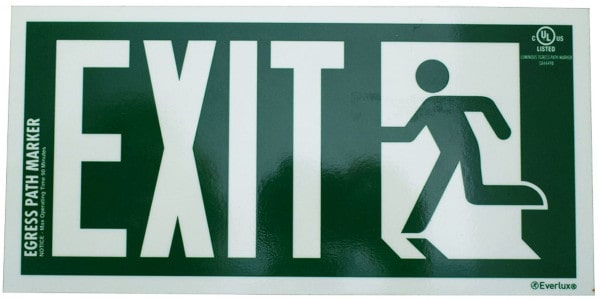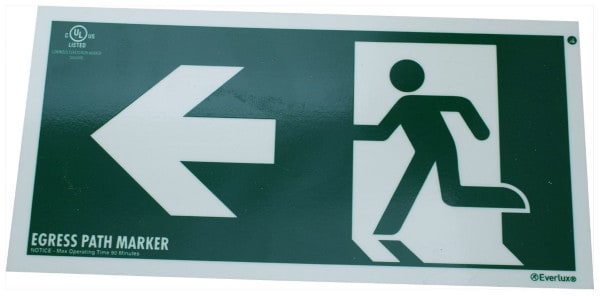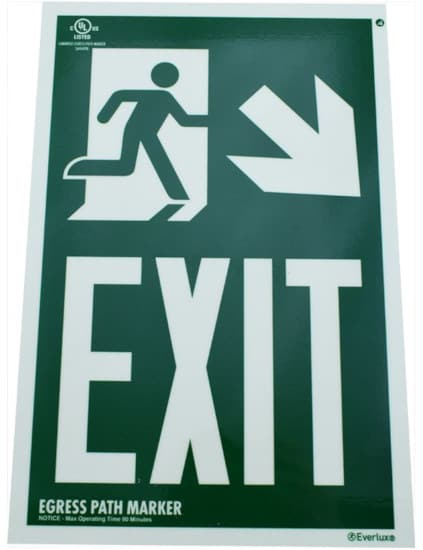Modern life safety codes make tall buildings safer during an emergency
Photoluminescent egress signs fill in the gaps between exit signs. In structures ranging from high-rise apartments to the record-breaking “megatall” towers of the world, tall buildings without photoluminescent safety signs can turn into dangerous mazes—filled with a series of locked doors, dead-end stairwells, and confusing intersections.
In this article, we explain when leading codes do (and don’t) require glow-in-the-dark signs made with photoluminescent materials. You’ll get an understanding of why these egress signs can’t be used in the place of exit signs, and where they’re typically used. We finish with a look at the rules for photoluminescent safety signs in New York City.
If you’re looking to replace an existing photoluminescent safety sign—or are already familiar with the finer points of egress sign requirements—browse our selection of photoluminescent safety signs, such as:
- NYC & IBC-compliant green-and-white egress markers used with doors not at the end of an exit path
- Photoluminescent signs with diagonal arrows used to mark the entrance to a stairwell
- Directional signs designed for mounting just above floor-level
- Our UL 924-listed, photoluminescent exit signs
Photoluminescent egress signs, required by the most widely-used building codes, aren’t exit signs
Which codes require photoluminescent safety signs? Here’s the short answer: the 2018 edition of the International Building Code (IBC)—which has been adopted in part or whole within all 50 U.S. states—allows, and sometimes requires, photoluminescent signs along paths leading to exits. So do the rules of New York City, New York (which are based on the IBC). Other reigning standards, like the National Building Code of Canada (NBC) and NFPA 101: Life Safety Code, permit (but do not require) their use.
Those requirements apply almost exclusively to high-rise structures. What’s more, they deal largely with photoluminescent egress path markers and not exit signs. Both types of sign aid in evacuation efforts—and both may feature the word “EXIT”—but egress path markers may not be used as traditional exit signs, in part because they:
- Don’t glow as brightly
- Usually have smaller letters
- Aren’t tested, vetted, or designed in the same way
Egress path markers supplement exit signs. Some use an arrow and image to indicate the presence of an exit stairway. Others provide continuity, ensuring that people don’t get confused on their way out of a building.
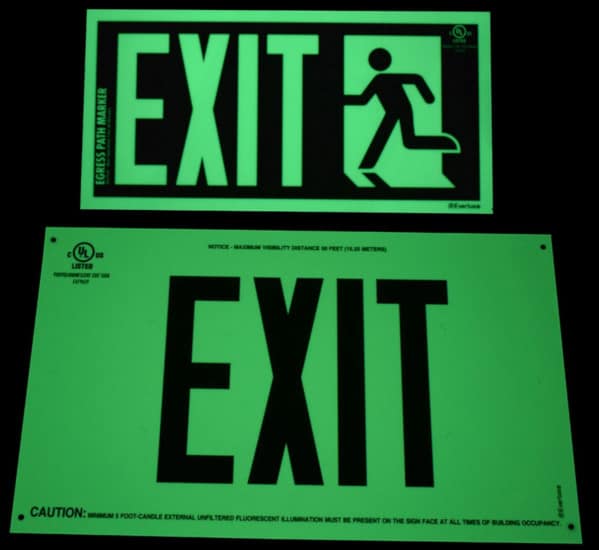
What’s more, exit signs generally need to charge faster, shine brighter, and remain legible from further away than do egress path markers. The crucial differences between exit and egress signs are codified by a handful of national, international, and local standards:
- In NFPA 101 and the IBC, UL 924 acts as the go-to listing for exit Before becoming UL-listed, these products must undergo third-party evaluation and/or testing.
- UL 1994 plays the same role for egress path markers.
- ASTM E 2072 provides guidelines for manufacturers of photoluminescent safety markers. Note, however, that products aren’t “ASTM-listed.” It’s important (and even required) that photoluminescent safety signs be vetted by a laboratory or other organization.
- NYC RS 6-1 provides design and placement standards for photoluminescent safety signs used in New York City (NYC). The city’s laws now require compliance with the demanding standards listed above—but manufacturers and retailers may still market their products as “compliant with NYC RS 6-1,” “NYC/MEA approved,” or as “New York City egress signs.”
Jurisdictions embracing the International Building Code require photoluminescent egress signs (or a similar alternative) in high-rises
IBC exit signs need not be photoluminescent
When it comes to exit signs, the IBC allows installers to choose between electric or photoluminescent sources of illumination. Section 1013 of the 2018 edition requires that these signs—whichever type—are:
- Visible from any direction of egress travel
- Make the direction of the exit clear (with arrows or directional indicators, as needed)
- Bear a UL 924 (exit sign) listing
The IBC requires these signs in most but not all occupancies, making exceptions for bedrooms, dwelling units, rooms with only one exit, and select other locations. Photoluminescent exit signs installed under the IBC are listed, labeled, and installed as the manufacturer specifies.
The most common non-electric “luminous egress path markings” are either photoluminescent or radioactive
For the most part, the IBC offers installers a choice between electric and non-electric signs. But luminous egress path markings—non-electric, glow-in-the-dark signs found along the means of egress—must not use electricity. Section 1025.4 restricts installers’ selection to signs that do not need an “electrical charge” to glow. Effectively, that leaves:
- Tritium signs, which use small amounts of radioactive gas to glow
- Photoluminescent signs that transform tape, paint, plastic, or film into a luminous surface with the help of light-absorbing phosphors
Both types of signs have a place: tritium models, for example, may be the only option when there’s no available light source to charge a photoluminescent sign. But tritium can also be significantly more expensive—and few manufacturers supply them with the colors, arrows, and symbols typically required. Photoluminescent signs, on the other hand, cost less and easily take on a variety of styles.
Most of these signs will feature symbols from NFPA 170: Standard for Fire Safety and Emergency Symbols. Each is at least 4” tall, and often includes an arrow indicating which way to go.
From the 2018 edition of the International Building Code
1025.2.6.1 Emergency exit symbol.
The doors shall be identified by a low-location luminous emergency exit symbol complying with NFPA 170. The exit symbol shall be not less than 4 inches (102 mm) in height […]
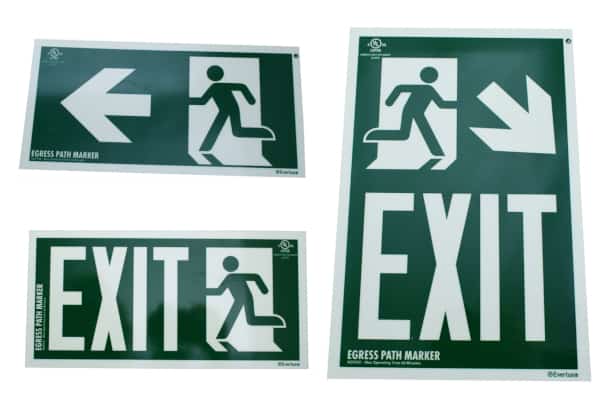
Whether tritium or photoluminescent, all safety signs must meet minimum standards—either those found in UL 1994 or a modified version of ASTM E2072. These standards guarantee that signs’ light levels won’t decrease too rapidly when properly charged.
From the 2018 edition of the International Building Code
1025.4 Self-luminous and photoluminescent.
[…] Materials shall comply with either of the following standards:
- UL 1994.
- ASTM E 2072, except that the charging source shall be 1 footcandle (11 lux) of fluorescent illumination for 60 minutes, and the minimum luminance shall be 30 milicandelas per square meter at 10 minutes and 5 milicandelas per square meter after 90 minutes.
Any sign used as an egress path marker must recharge within 60 minutes. When the charging light turns off, the sign must glow at a specified brightness over 90 minutes. Natural lighting won’t do the trick: all photoluminescent egress path markers must be exposed to light for 60 minutes before the building is occupied and continuously charged while people are in the building (IBC: 1025.5).
Doors in tall shopping centers, schools, apartments, and other facilities need consistent signage
In Section 202, the IBC defines the “means of egress” as “[a] continuous and unobstructed path of vertical and horizontal egress travel from any occupied portion of a building or structure to a public way.” In other words: doors at passageways, stairways, and ramps leading to an exit need glow-in-the-dark signs.
Specifically, luminous egress path markings are required in high-rises categorized as:
- Group A: Assembly occupancies, such as restaurants, bars, churches, stadiums, and skating rinks
- Group B: Business and professional occupancies ranging from universities to laboratories
- Group E: Educational facilities for six or more people (up to the 12th grade)
- Group I-1: Institutions that provide supervised “personal care service” to 16 people or more, like assisted living facilities and drug rehabilitation centers
- Group M: For merchandising—department stores, grocery stores, and so on
- Group R-1: Residential occupancies where stays are short, such as hotels and motels
Don’t mix and match these signs. The IBC requires consistent dimensions and placement for photoluminescent egress signs within an enclosure, like a hallway or stairwell (1025.3). These must be placed on the center of any door leading to an exit—no higher than 18” above the floor (1025.2.6-1025.2.6.1). The only doors exempt from this requirement are those in select fire-protected lobbies near a final exit (for more, see section 1025.1).
View our shopping list of IBC-compliant photoluminescent egress signs.
New York City’s laws on photoluminescent safety signs resemble (but aren’t identical to) the IBC’s
When it comes to the use of photoluminescent safety signs in New York City, a few laws or standards are often mentioned:
- NYC Local Law 26, which added requirements for photoluminescent egress path markers in 2004
- Reference Standard 6-1 (RS 6-1), a set of standards for photoluminescent safety signs in high-rises
- NYC Local Law 141, which made much of the IBC (2009 edition) binding
All are ultimately part of the city’s building codes. These rules resemble—but aren’t the same as—those found in the IBC. Here are the key take-aways:
- NYC’s administrative code doesn’t choose between photoluminescent and radioluminescent (e.g., tritium) signs
- While manufacturers still mention RS 6-1, photoluminescent egress signs in New York City must now meet the more demanding standards of UL 1994 or ASTM E 2072
- All buildings over a certain height need egress path markings—not just those belonging to certain occupancy types
- Required signs include wall-mounted directional signs and low-location symbols placed near the floor
- Signs must adhere to specific designs and colors
View our shopping list of NYC-compliant photoluminescent egress signs.
New York City requires non-electric, glow-in-the-dark signs in high-rise buildings
Title 28, Chapter 7 of the New York City Administrative Code contains the city’s building code. It requires “approved luminous egress path markings” in buildings that have occupied floors located over 75 feet above the lowest level of fire department vehicle access. These markings aren’t needed:
- In some sprinklered lobbies “on the level of exit discharge”
- With some exit staircases found in open parking garages
For more on these exceptions, see section 1024.1. But apart from these areas, doors and hallways leading to the exits of New York City’s tall buildings will feature a variety of egress markers, including:
- Low-location emergency exit symbols, placed on “doors through which occupants within an exit enclosure must pass in order to complete the exit path, and doors serving horizontal exits” (1024.2.6)
- Low-location directional signs at every entrance to an exit enclosure—passageways protected fire-resistant construction—that include an arrow indicating the direction of travel (1024.2.7)
- Wall-mounted directional signs at “transfer levels and where egress direction is not clear,” including at T-intersections and where stairwells fork (1024.2.8)
Both the Administrative Code and the International Building Code require these signs to comply with either UL 1994 or a more rigorous version of ASTM E 2072. However, New York City’s rules are more specific on how photoluminescent safety signs should look:
- They can be either “positive or negative image”—meaning that the symbols and text, or the background surrounding them, may glow.
- Each must use a “safety green” color for non-photoluminescent sections. The exact definition is provided by the American National Standards Institute (ANSI) in their standard ANSI Z535.1.
- The word “EXIT” (in sans serif letters) must be featured with door signs, using strokes at least 1/2” wide and letters at least 4” tall.
- Each must have the appropriate NFPA 170 emergency exit symbol—and it must be at least 4” tall.
- Similarly, each sign requiring an arrow must use one that’s at least 2 3/4” high and that complies with NFPA 170.
- The sign’s dimensions and design must comply with one of the figures provided in the city’s building code.
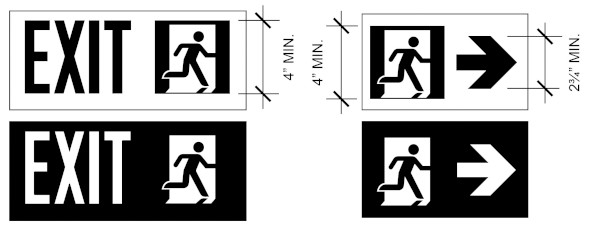
Keep people in your building out of harm’s way with photoluminescent safety signs
As buildings grow taller, the need to quickly locate an exit becomes even more urgent. Photoluminescent egress signs can make that task far easier, creating a clear and continuous path from the rooms where people work and live to places of safety.
Replacing or installing photoluminescent safety signs? The shopping list below can help you figure out if our products and your code are compatible. Take a look, browse our catalog, or reach out at 1 (888) 361-6662 and support@qrfs.com.
Shop IBC and NYC-Compliant Photoluminescent Safety Signs
12″ x 6″ Door Marker
|
|
12″ x 6″ Directional Marker with Arrow & Symbol |
|
8″ x 12″ Stairwell Marker with Arrow & Symbol |
|
This blog was originally posted at blog.qrfs.com. If this article helped you, check us out at Facebook.com/QuickResponseFireSupply or on Twitter @QuickResponseFS.


